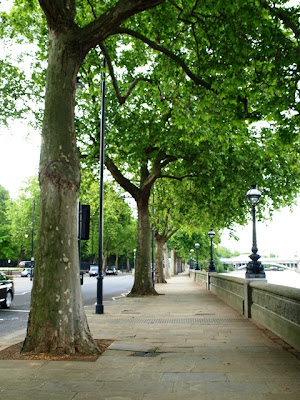Learning to love London planes
Living in Kew Gardens, I am very familiar with London planes. I mean we have jumbos banking over our house three days out of four, sometimes on the minute, as they descend into Heathrow...
This gets the aeronautical pun out of the way, so now to botanical matters. I was reminded by a book review in today's Guardian that London Planes - the quieter more environmentally friendly (although more on that later) ones - are a hybrid between a species from the eastern Mediterranean (the Oriental Plane) and one from eastern North America (the Western Plane or American Sycamore). That is, nothing much to do with London.
The scientific name for this multicultural tree is Platanus x acerifolius, or incorrectly, Platanus x hispanica. It started as an accidental cross between Platanus orientalis and Platanus occidentalis some 300 years ago, somewhere in Spain (hence one of its scientific names).
The hybrid or cultivar most probably arrived in London thanks to Charles I's gardener, John Tradescant. Tradescant had a garden in Lambeth, about 10 miles east of where I'm sitting now. He brought American Sycamores back to England and grew them next to Oriental Planes but there doesn't seem to have been time for them to flower and cross before the London Plane craze took off. It seems more likely he brought one of these new hybrids over from Spain during a European journey. He was certainly responsible for distributing and planting them throughout London. My picture at the top of the blog is a more recent planting beside the Thames near Westminster.
Back in Sydney I used to argue Planes were a dull urban tree, the favourite of lazy landscapers and local politicians. They can look good in Australian cities, and Melbourne, particularly, does them well. In Sydney, though, there are plenty of local and exotic alternatives that are more interesting and adventurous. Planes were for the dull of heart and mind.
In London? Well they have been part of the urban landscape for so long (but no more than 300 years presumably) and they survive the climate and concrete. I like them here. I also like them elsewhere in the British Isles. That said, I prefer the Oriental Plane, with its warty, bottle-like trunk in older specimens, such the 250 year-old specimens in Kew Gardens and this pair of 150 year-olds from Trinity College.
Quite a few people in Sydney dislike planes not, as I did, because they were a dull choice, but because they feared for their health. Hairs released from young leaves and seeds can be irritating if breathed in and are particularly concerning for asthma sufferers. The leaves also take such a long time to break down that they irritate people who like clean paths.
On the whole though the London Plane provides a positive benefit in a big city, sucking up carbon dioxide and pollutants, and adding oxygen and joy. Just don't over do it.


Comments
But oh, when they are allowed to grow to their full glory, they are magnificent...